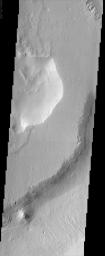Medusae Fossae
Caption:

(Released 31 July 2002)
This image crosses the equator at about 155 W longitude and shows a sample of the middle member of the Medusae Fossae formation. The layers exposed in the southeast-facing scarp suggest that there is a fairly competent unit underlying the mesa in the center of the image. Dust-avalanches are apparent in the crater depression near the middle of the image. The mesa of Medusae Fossae material has the geomorphic signatures that are typical of the formation elsewhere on Mars, but the surface is probably heavily mantled with fine dust, masking the small-scale character of the unit. The close proximity of the Medusae Fossae unit to the Tharsis region may suggest that it is an ignimbrite or volcanic airfall deposit, but it's eroded character hasn't preserved the primary depositional features that would give away the secrets of formation. One of the most interesting feature in the image is the high-standing knob at the base of the scarp in the lower portion of the image. This knob or butte is high standing because it is composed of material that is not as easily eroded as the rest of the unit. There are a number of possible explanations for this feature, including volcano, inverted crater, or some localized process that caused once friable material to become cemented. Another interesting set of features are the long troughs on the slope in the lower portion of the image. The fact that the features keep the same width for the entire length suggests that these are not simple landslides.
Cataloging Keywords:
| Name |
Value |
Additional Values |
| Target |
Mars |
|
| System |
|
|
| Target Type |
Planet |
|
| Mission |
2001 Mars Odyssey |
|
| Instrument Host |
Mars Odyssey |
|
| Host Type |
Orbiter |
|
| Instrument |
Thermal Emission Imaging System (THEMIS) |
|
| Detector |
|
|
| Extra Keywords |
Crater, Dust, Grayscale, Volcano |
| Acquisition Date |
|
| Release Date |
2002-08-05 |
| Date in Caption |
2002-07-31 |
|
| Image Credit |
NASA/JPL/Arizona State University |
| Source |
photojournal.jpl.nasa.gov/catalog/PIA03910 |
| Identifier |
PIA03910 |


